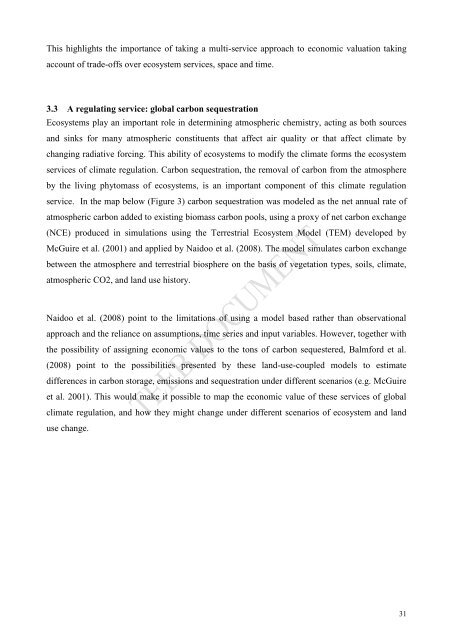Chapter 3 Measuring biophysical quantities and the use of ... - TEEB
Chapter 3 Measuring biophysical quantities and the use of ... - TEEB
Chapter 3 Measuring biophysical quantities and the use of ... - TEEB
You also want an ePaper? Increase the reach of your titles
YUMPU automatically turns print PDFs into web optimized ePapers that Google loves.
This highlights <strong>the</strong> importance <strong>of</strong> taking a multi-service approach to economic valuation takingaccount <strong>of</strong> trade-<strong>of</strong>fs over ecosystem services, space <strong>and</strong> time.3.3 A regulating service: global carbon sequestrationEcosystems play an important role in determining atmospheric chemistry, acting as both sources<strong>and</strong> sinks for many atmospheric constituents that affect air quality or that affect climate bychanging radiative forcing. This ability <strong>of</strong> ecosystems to modify <strong>the</strong> climate forms <strong>the</strong> ecosystemservices <strong>of</strong> climate regulation. Carbon sequestration, <strong>the</strong> removal <strong>of</strong> carbon from <strong>the</strong> atmosphereby <strong>the</strong> living phytomass <strong>of</strong> ecosystems, is an important component <strong>of</strong> this climate regulationservice. In <strong>the</strong> map below (Figure 3) carbon sequestration was modeled as <strong>the</strong> net annual rate <strong>of</strong>atmospheric carbon added to existing biomass carbon pools, using a proxy <strong>of</strong> net carbon exchange(NCE) produced in simulations using <strong>the</strong> Terrestrial Ecosystem Model (TEM) developed byMcGuire et al. (2001) <strong>and</strong> applied by Naidoo et al. (2008). The model simulates carbon exchangebetween <strong>the</strong> atmosphere <strong>and</strong> terrestrial biosphere on <strong>the</strong> basis <strong>of</strong> vegetation types, soils, climate,atmospheric CO2, <strong>and</strong> l<strong>and</strong> <strong>use</strong> history.Naidoo et al. (2008) point to <strong>the</strong> limitations <strong>of</strong> using a model based ra<strong>the</strong>r than observationalapproach <strong>and</strong> <strong>the</strong> reliance on assumptions, time series <strong>and</strong> input variables. However, toge<strong>the</strong>r with<strong>the</strong> possibility <strong>of</strong> assigning economic values to <strong>the</strong> tons <strong>of</strong> carbon sequestered, Balmford et al.(2008) point to <strong>the</strong> possibilities presented by <strong>the</strong>se l<strong>and</strong>-<strong>use</strong>-coupled models to estimatedifferences in carbon storage, emissions <strong>and</strong> sequestration under different scenarios (e.g. McGuireet al. 2001). This would make it possible to map <strong>the</strong> economic value <strong>of</strong> <strong>the</strong>se services <strong>of</strong> globalclimate regulation, <strong>and</strong> how <strong>the</strong>y might change under different scenarios <strong>of</strong> ecosystem <strong>and</strong> l<strong>and</strong><strong>use</strong> change.31
















